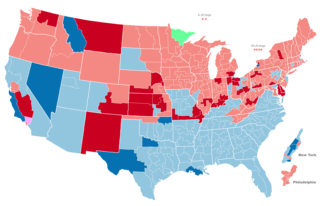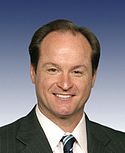
John Alfred Sullivan is an American politician who was the U.S. representative for Oklahoma's 1st congressional district from 2002 to 2013. He is a member of the Republican Party.

The 1996 United States Senate elections were held on November 5, with the 33 seats of Class 2 contested in regular elections. Special elections were also held to fill vacancies. They coincided with the presidential election of the same year, in which Democrat Bill Clinton was re-elected president.

The 1984 United States Senate elections were held on November 6, with the 33 seats of Class 2 contested in regular elections. They coincided with the landslide re-election of President Ronald Reagan in the presidential election. In spite of the lopsided presidential race, Reagan's Republican Party suffered a net loss of two Senate seats to the Democrats, although it retained control of the Senate with a reduced 53–47 majority. Democrats defeated incumbents in Illinois and Iowa, and won an open seat in Tennessee, while Republicans defeated an incumbent in Kentucky.

The 1970 United States Senate elections was an election for the United States Senate. It took place on November 3, with the 33 seats of Class 1 contested in regular elections. Special elections were also held to fill vacancies. These races occurred in the middle of Richard Nixon's first term as president. The Democrats lost a net of three seats, while the Republicans and the Conservative Party of New York picked up one net seat each, and former Democrat Harry F. Byrd Jr. was re-elected as an independent.

The 1964 United States Senate elections were held on November 3. The 33 seats of Class 1 were contested in regular elections. Special elections were also held to fill vacancies. They coincided with the election of President Lyndon B. Johnson by an overwhelming majority, to a full term. His Democratic Party picked up a net two seats from the Republicans. As of 2023, this was the last time either party has had a two-thirds majority in the Senate, which allowed the Senate Democrats to override a veto, propose constitutional amendments, or convict and expel certain officials without any votes from Senate Republicans. However, internal divisions would have prevented the Democrats from having done so. The Senate election cycle coincided with Democratic gains in the House in the same year.

The 1958 United States Senate elections were elections for the United States Senate which occurred in the middle of President Dwight D. Eisenhower's second term. Thirty-two seats of Class 1 were contested in regular elections, the new state of Alaska held its first Senate elections for its Class 2 and 3 seats, and two special elections were held to fill vacancies.

The 1930 United States Senate elections occurred in the middle of Republican President Herbert Hoover's term. The 32 seats of Class 2 were contested in regular elections, and special elections were held to fill vacancies. With the Great Depression beginning to take hold, Republican incumbents became unpopular, and Democrats picked up a net of eight seats, erasing the Republican gains from the previous election cycle, however, Republicans retained control of the chamber. This was the first of four consecutive Senate elections during the Depression in which Democrats made enormous gains, achieving a cumulative pick-up of 34 seats.

The 1918 United States House of Representatives elections were elections for the United States House of Representatives to elect members to serve in the 66th United States Congress. They were held for the most part on November 5, 1918, while Maine held theirs on September 9. They occurred in the middle of President Woodrow Wilson's second term.
The 1908 United States House of Representatives elections were held for the most part on November 3, 1908, with Oregon, Maine, and Vermont holding theirs early in either June or September. They coincided with the 1908 United States presidential election, which William Howard Taft won. Elections were held for all 391 seats of the United States House of Representatives, representing 46 states, to serve in the 61st United States Congress.

The 1894 United States House of Representatives elections were held from June 4, 1894, to November 6, 1894, with special elections throughout the year. Elections were held to elect representatives from all 356 congressional districts across each of the 44 U.S. states at the time, as well as non-voting delegates from the inhabited U.S. territories. The winners of this election served in the 54th Congress, with seats apportioned among the states based on the 1890 United States census.

The 1892 United States House of Representatives elections were held for the most part on November 8, 1892, with Oregon, Maine, and Vermont holding theirs early in either June or September. They coincided with the election of Grover Cleveland as president for the second, non-continuous, time, defeating incumbent Benjamin Harrison. Elections were held for 356 seats of the United States House of Representatives, representing 44 states, to serve in the 53rd United States Congress. They were the first elections after reapportionment following the 1890 United States census, increasing the size of the House. Special elections were also held throughout the year.

The 1866–67 United States House of Representatives elections were held on various dates in various states between June 4, 1866, and September 6, 1867. They occurred during President Andrew Johnson's term just one year after the American Civil War ended when the Union defeated the Confederacy. Each state set its own date for its elections to the House of Representatives. Members were elected before or after the first session of the 40th United States Congress convened on March 4, 1867, including the at-large seat from the new state of Nebraska. Ten secessionist states still had not yet been readmitted, and therefore were not seated.

The 1858–59 United States House of Representatives elections were held on various dates in various states between June 7, 1858, and December 1, 1859. Each state set its own date for its elections to the House of Representatives. 238 representatives were elected in the new state of Oregon, the pending new state of Kansas, and the other 32 states before the first session of the 36th United States Congress convened on December 5, 1859. They were held during President James Buchanan's term.

The 2010 congressional elections in Oklahoma were held on November 2, 2010, to determine who would represent the state of Oklahoma in the United States House of Representatives. Oklahoma has five seats in the House, apportioned according to the 2000 United States census. This election was the final one held in which congressional districts apportioned according to the 2000 U.S. census data. Representatives are elected for two-year terms; those elected serve in the 112th Congress from January 3, 2011, until January 3, 2013.

The 2004 United States House of Representatives special election in Kentucky's 6th congressional district was held on February 17, 2004, to select the successor to Ernie Fletcher (R) who resigned upon being elected Governor of Kentucky. Each party held a nominating convention to choose their nominee for the special election. Republicans selected state Senator Alice Kerr over state Representatives Stan Lee and Lonnie Napier and Lexington city councilman Charles Ellinger II as their nominee while Democrats chose former state Attorney General and 2003 Democratic gubernatorial nominee Ben Chandler.

The 2014 United States House of Representatives elections in Oklahoma were held on Tuesday, November 4, 2014, to elect the five U.S. representatives from the state of Oklahoma, one from each of the state's five congressional districts. The elections coincided with other elections to the United States Senate and House of Representatives and various state and local elections, including the Governor of Oklahoma and both of Oklahoma's United States Senate seats. Primary elections were held on June 24, 2014. Primary runoffs were held on August 26, 2014, in contests where no candidate won more than 50% of the vote.

The 1977 United States House of Representatives special election in Minnesota's 7th congressional district was held on February 22, 1977 to select the successor to Bob Bergland (DFL) who resigned to accept appointment as Secretary of Agriculture under the Carter Administration. Independent-Republican candidate Arlan Stangeland defeated the DFL favorite, Mike Sullivan, in an upset landslide.

Kendra Suzanne Horn is an American lawyer and politician who served as the U.S. representative for Oklahoma's 5th congressional district from 2019 to 2021. A member of the Democratic Party, her district included almost all of Oklahoma City.
There were ten elections in 1907 to the United States House of Representatives. Five were special elections in the 60th United States Congress and the other five were new seats from the new state of Oklahoma. There were no special elections in 1907 during the 61st United States Congress.

The 2022 United States Senate special election in Oklahoma was held on November 8, 2022, to elect a member of the United States Senate for Oklahoma. The election took place concurrently with the regularly scheduled election for Oklahoma's other Senate seat. The candidate filing deadline was between April 13 and 15, 2022.




















